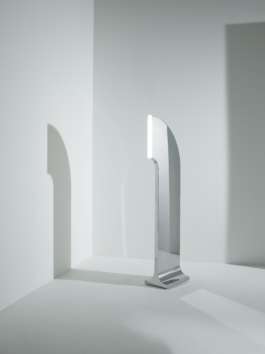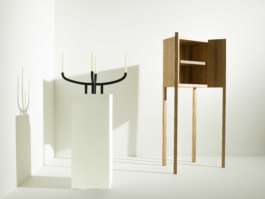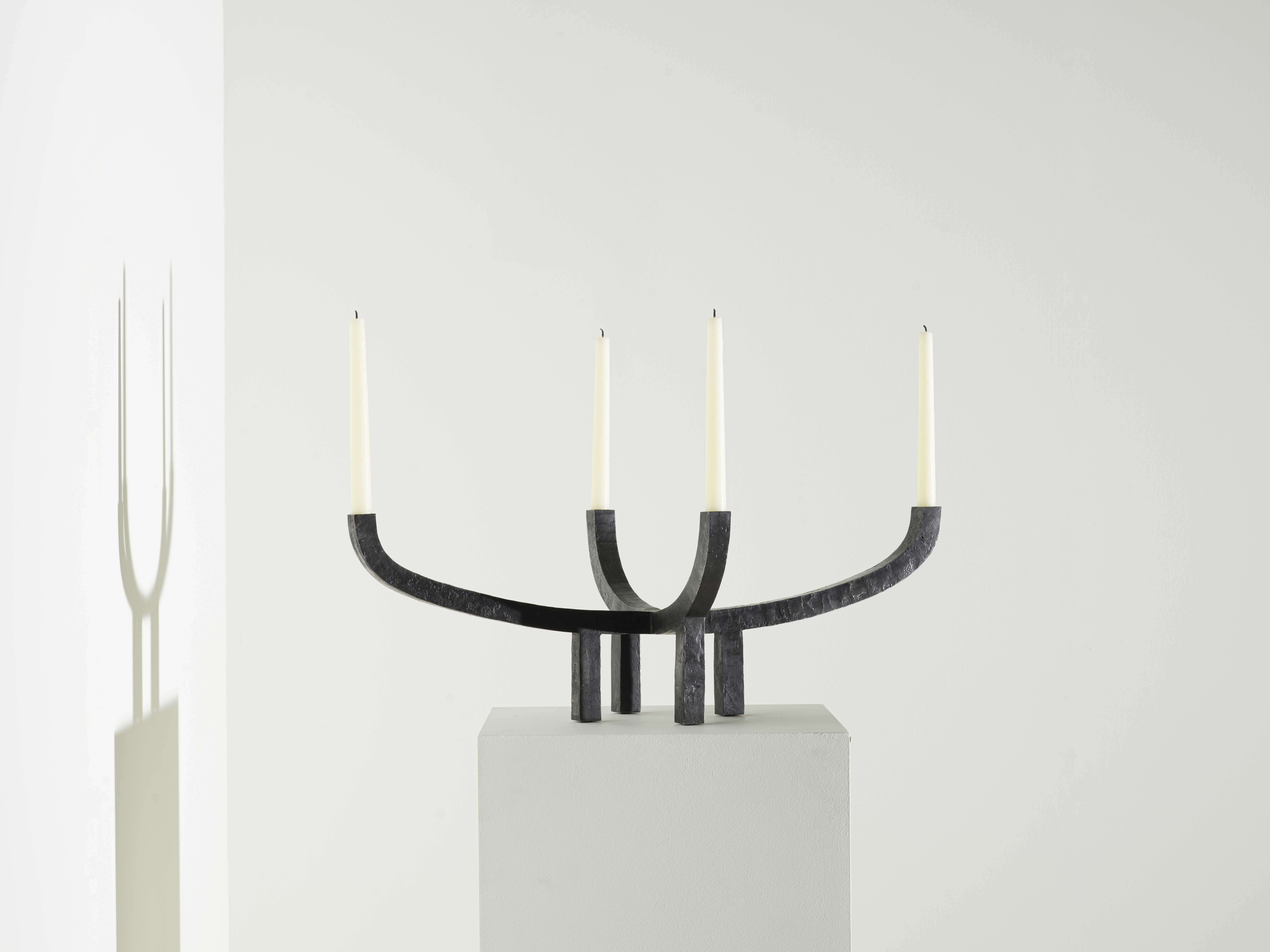



ÆTHER/MASS, Beam Lamp, 2023 © Jean Van Cleemput
COLLECTIBLE In-Depth
March 2024
This series, COLLECTIBLE In-Depth, unveils the backstage of contemporary creation. Tackling various topics from personal designer processes to the position of collectible design on the global design market, COLLECTIBLE In-Depth offers different views to suit all tastes. Today we speak with Davy Grosemans from ÆTHER/MASS.
COLLECTIBLE: How did you get into collectible design? Why did you focus your practice on this type of design rather than industrial design?
Davy Grosemans: I started ÆTHER/MASS in 2022 as a quest to reclaim my personal voice in design after years of navigating the complexities of client projects. With over two decades of experience as an industrial designer and interior architect, I always had to balance delicately between client expectations, personal vision, budget limitations, and diverse opinions. While these experiences broadened my perspective on design, I also sensed a gradual loss of my own creative identity amidst the demands of commercial projects. The goal of ÆTHER/MASS was to create a world where I could freely express my ideas without external constraints, serving as a platform for pure self-expression and unfettered imagination. Liberated from client briefings, I embraced the challenge of being my own critic and guide, seeking feedback from within and navigating the creative process with autonomy. This project represents a departure from the conventional design practice, where the focus shifts from meeting external demands to delving deep into the realm of self-discovery and uninhibited creativity.
C: Can you briefly describe your process?
DG: For years, I have been doodling on scrap pieces of paper while scrolling through thousands of inspirational images of art and architecture, bringing me in some kind of “stream of unconsciousness”. Without focusing on anything in particular, I let those images enter my mind and mingle while sketching. At the end of the day, I scan them in and let them rest for a few weeks or months. When I look at them at a screen afterwards, they appear to me as somebody elses sketches, allowing me for the necessary distance to evaluate them. With a focused mind, I question myself: do they speak to me? If there is something that triggers my emotion, I will develop the sketch into a virtual 3D-model to see if it can be translated into something scaleable with good proportions. In the meantime, I try to figure out why this sketch triggered my imagination. Is there a meaning to the form? If there is no why and only a beautiful shape, it doesn’t stand the test. When why and what is determined, I look for the how: how can this be made and by who? That’s when the quest for the suitable craftsman starts.
C: How do you question or challenge functionality in your design process?
DG: The phrase "objects in search of meaning" encapsulates my design philosophy, which goes beyond mere functionality to prioritize storytelling and conceptual depth within each creation. While functionality remains a crucial aspect of my designs, it does not overshadow the quest for deeper significance. In my approach, I believe that design should not be limited to fulfilling practical needs alone. Instead, I view objects as vessels for narratives, capable of conveying emotions, cultural references, and symbolic meanings. By imbuing each object with layers of significance, I aim to evoke curiosity and engagement from the audience, inviting them to explore beyond the surface level of utility. This emphasis on meaning does not diminish the importance of function; rather, it enriches the design by offering multiple dimensions for interpretation. By intertwining form and narrative, I seek to create objects that resonate with users on a deeper level, fostering connections and sparking conversations.
C: What is your favorite material?
DG: Personally, I think all materials have the potential to become my favorite material and the source of inspiration for a new collection. The craftsmen I collaborate with are individuals who have an in-depth knowledge of their materials and can deliver exceptionally high quality. Personally, I aim to think broadly, sample various aspects, and experiment with different materials and processes initially. Subsequently, I can delve deeper into the matter. This year, the new collection features metal objects born out of new collaborations with different workshops. This results in three designs, crafted from aluminum, wrought iron, and mirror stainless steel, each exploring and delving into the intrinsic properties and characteristics of the material "metal" in various ways. In the first collection, we focused more on the characteristics of solid wood and its various techniques used in processing this material. A good example is the Lathe series. This collection of small tables draws inspiration from the classical turned leg, found beneath numerous wooden tables. By deconstructing the table and utilizing solely its legs results in the creation of a collection featuring stools, side tables and pedestals. The name of this collection refers to the lathe, a machine tool that rotates a piece of wood about an axis of rotation to perform various operations such as cutting, sanding and turning. The end result is an object characterized by a profound symmetry emanating from its central axis.

ÆTHER/MASS, Forge & Exposure, 2023 © Jean Van Cleemput

ÆTHER/MASS, Forge, 2023 © Jean Van Cleemput
COLLECTIBLE In-Depth
March 2024

ÆTHER/MASS, Beam Lamp, 2023 © Jean Van Cleemput
This series, COLLECTIBLE In-Depth, unveils the backstage of contemporary creation. Tackling various topics from personal designer processes to the position of collectible design on the global design market, COLLECTIBLE In-Depth offers different views to suit all tastes. Today we speak with Davy Grosemans from ÆTHER/MASS.
COLLECTIBLE: How did you get into collectible design? Why did you focus your practice on this type of design rather than industrial design?
Davy Grosemans: I started ÆTHER/MASS in 2022 as a quest to reclaim my personal voice in design after years of navigating the complexities of client projects. With over two decades of experience as an industrial designer and interior architect, I always had to balance delicately between client expectations, personal vision, budget limitations, and diverse opinions. While these experiences broadened my perspective on design, I also sensed a gradual loss of my own creative identity amidst the demands of commercial projects. The goal of ÆTHER/MASS was to create a world where I could freely express my ideas without external constraints, serving as a platform for pure self-expression and unfettered imagination. Liberated from client briefings, I embraced the challenge of being my own critic and guide, seeking feedback from within and navigating the creative process with autonomy. This project represents a departure from the conventional design practice, where the focus shifts from meeting external demands to delving deep into the realm of self-discovery and uninhibited creativity.
C: Can you briefly describe your process?
DG: For years, I have been doodling on scrap pieces of paper while scrolling through thousands of inspirational images of art and architecture, bringing me in some kind of “stream of unconsciousness”. Without focusing on anything in particular, I let those images enter my mind and mingle while sketching. At the end of the day, I scan them in and let them rest for a few weeks or months. When I look at them at a screen afterwards, they appear to me as somebody elses sketches, allowing me for the necessary distance to evaluate them. With a focused mind, I question myself: do they speak to me? If there is something that triggers my emotion, I will develop the sketch into a virtual 3D-model to see if it can be translated into something scaleable with good proportions. In the meantime, I try to figure out why this sketch triggered my imagination. Is there a meaning to the form? If there is no why and only a beautiful shape, it doesn’t stand the test. When why and what is determined, I look for the how: how can this be made and by who? That’s when the quest for the suitable craftsman starts.
C: How do you question or challenge functionality in your design process?
DG: The phrase "objects in search of meaning" encapsulates my design philosophy, which goes beyond mere functionality to prioritize storytelling and conceptual depth within each creation. While functionality remains a crucial aspect of my designs, it does not overshadow the quest for deeper significance. In my approach, I believe that design should not be limited to fulfilling practical needs alone. Instead, I view objects as vessels for narratives, capable of conveying emotions, cultural references, and symbolic meanings. By imbuing each object with layers of significance, I aim to evoke curiosity and engagement from the audience, inviting them to explore beyond the surface level of utility. This emphasis on meaning does not diminish the importance of function; rather, it enriches the design by offering multiple dimensions for interpretation. By intertwining form and narrative, I seek to create objects that resonate with users on a deeper level, fostering connections and sparking conversations.
C: What is your favorite material?
DG: Personally, I think all materials have the potential to become my favorite material and the source of inspiration for a new collection. The craftsmen I collaborate with are individuals who have an in-depth knowledge of their materials and can deliver exceptionally high quality. Personally, I aim to think broadly, sample various aspects, and experiment with different materials and processes initially. Subsequently, I can delve deeper into the matter. This year, the new collection features metal objects born out of new collaborations with different workshops. This results in three designs, crafted from aluminum, wrought iron, and mirror stainless steel, each exploring and delving into the intrinsic properties and characteristics of the material "metal" in various ways. In the first collection, we focused more on the characteristics of solid wood and its various techniques used in processing this material. A good example is the Lathe series. This collection of small tables draws inspiration from the classical turned leg, found beneath numerous wooden tables. By deconstructing the table and utilizing solely its legs results in the creation of a collection featuring stools, side tables and pedestals. The name of this collection refers to the lathe, a machine tool that rotates a piece of wood about an axis of rotation to perform various operations such as cutting, sanding and turning. The end result is an object characterized by a profound symmetry emanating from its central axis.

ÆTHER/MASS, Forge & Exposure, 2023 © Jean Van Cleemput

ÆTHER/MASS, Forge, 2023 © Jean Van Cleemput
Contact
info@collectible.design
VIP PORTAL
EXHIBITOR PORTAL
PRIVACY POLICY
© 2025 Collectible
Contact
info@collectible.design
VIP PORTAL
EXHIBITOR PORTAL
PRIVACY POLICY
© 2025 Collectible